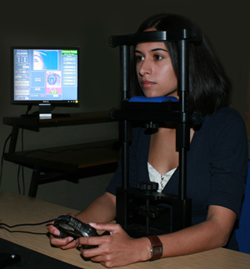Can triangles help spot a bomb?
Airport security staff have a daunting task. With impatient queues looming over them they need to search x-ray scans of cluttered suitcases for several items at once: knives, guns and bombs. How can we ease their task and make sure they don't miss a crucial item? To find out, scientists at the University of Southampton are trying to understand how we humans take in visual information. They are presenting their work at this year's Royal Society Summer Science Exhibition 2011, which runs from the 5th to the 10th of July. The humble triangle plays a crucial role in the experiments they perform.

Diagram 1
Eye tracking experiments record the eye movements of volunteers looking at an image on a screen to see what kind of visual features their eyes latch onto. It's important to know how big the visual stimuli on the screen are, but size is in the eye of the beholder. Even the biggest things look small when you're far enough away.
A clever way of taking account of this is to measure size in terms of the visual angle. The length of an object in an image, for example a knife, is measured in terms of the angle formed by the two lines starting at your eye and ending at either end of the object (see diagram 1). Using the visual angle to measure size, scientists can accurately compare results of different experiments that may have been run in laboratories with different sized stimuli and different viewing distances.
But how can you work out the visual angle from the actual size of an object on a screen and vice versa?

Diagram 2
Suppose the viewer’s gaze is directed right at the mid-point of the object on the screen, as shown in diagram 2. We write  for the visual angle,
for the visual angle,  for the length of the object on the screen and
for the length of the object on the screen and  for the viewing distance. The triangle
for the viewing distance. The triangle  has a right angle at the vertex
has a right angle at the vertex  . The angle at vertex
. The angle at vertex  is
is  .
.
A little trigonometry tells us that

Given an image of an object of length  , we can now work out how far we need to place the viewer from the screen to make sure they see the object at a visual angle
, we can now work out how far we need to place the viewer from the screen to make sure they see the object at a visual angle  :
:
![\[ D=h/(2\tan {(\alpha /2)}). \]](/MI/f0d4af54c96371a7639c5abec33b8666/images/img-0009.png) |
So if  and
and  , the necessary viewing distance is
, the necessary viewing distance is
![\[ D=5/2\tan {(0.5)}=5/0.017=286.47cm. \]](/MI/f0d4af54c96371a7639c5abec33b8666/images/img-0012.png) |
Similarly, given a fixed viewing distance  we can work out how big we need to make the image of the object to get a visual angle
we can work out how big we need to make the image of the object to get a visual angle  :
:
![\[ h=2\tan {(\alpha /2)}D. \]](/MI/f0d4af54c96371a7639c5abec33b8666/images/img-0013.png) |
For  and
and  we get
we get
![\[ h=200\tan {(0.5)}= 1.75cm. \]](/MI/f0d4af54c96371a7639c5abec33b8666/images/img-0015.png) |

An eye tracking experiment.
Finally, given a fixed viewing distance  and an object of length
and an object of length  , we can work out the visual angle as
, we can work out the visual angle as

So an image with  viewed at a distance of
viewed at a distance of  gives a visual angle of
gives a visual angle of

The visual angle is the standard way of measuring size in vision science, whether it's about improving airport security or understanding the psychology or biology of vision. It's also a favourite with astronomers, who for centuries have been using visual angles to describe the size of the Moon, the Sun and other celestial objects as viewed from Earth.
This article accompanies an exhibit at the Royal Society Summer Science Exhibition 2011 entitled Guns, knives, and bombs: How do airport security screeners spot weapons in x-rays of passenger baggage? It is part of the Maths Inside project, run by the Mathematics Promotion Unit (a collaboration between the London Mathematical Society and the Institute of Mathematics and its Applications) in conjunction with Plus and the Royal Society.
 |
 |
|
|